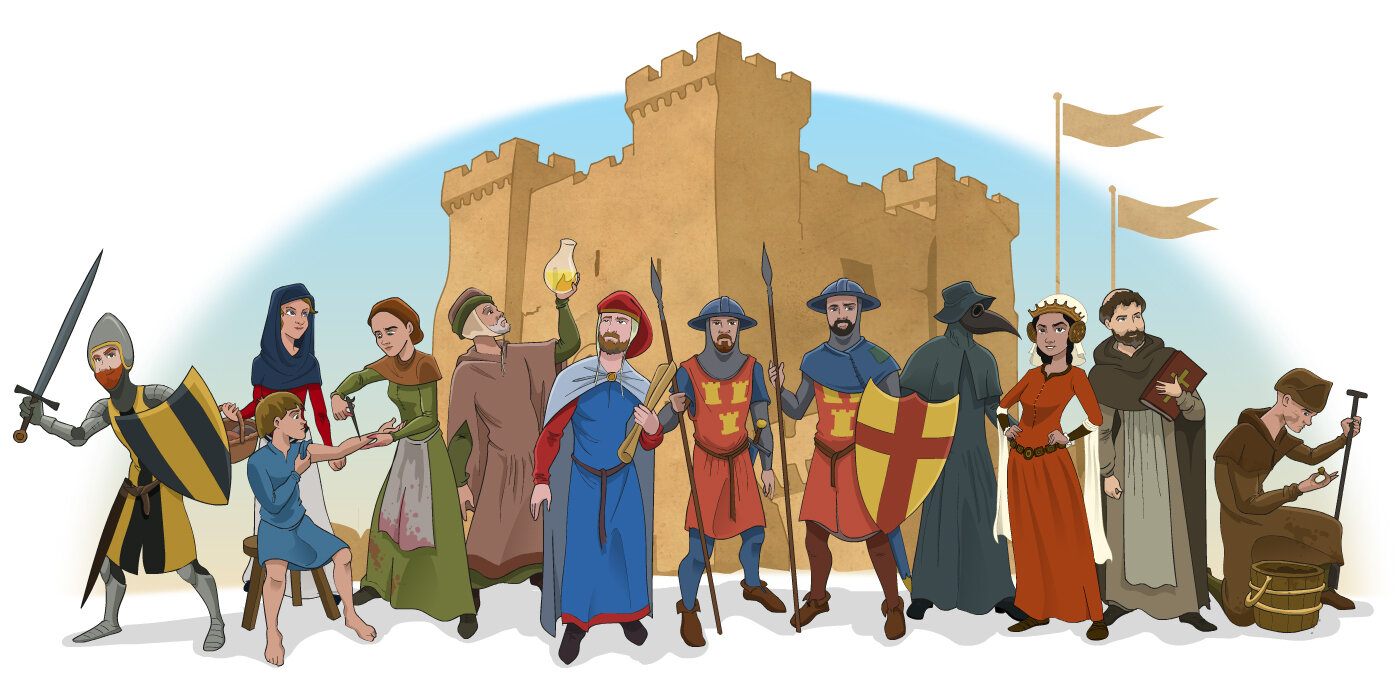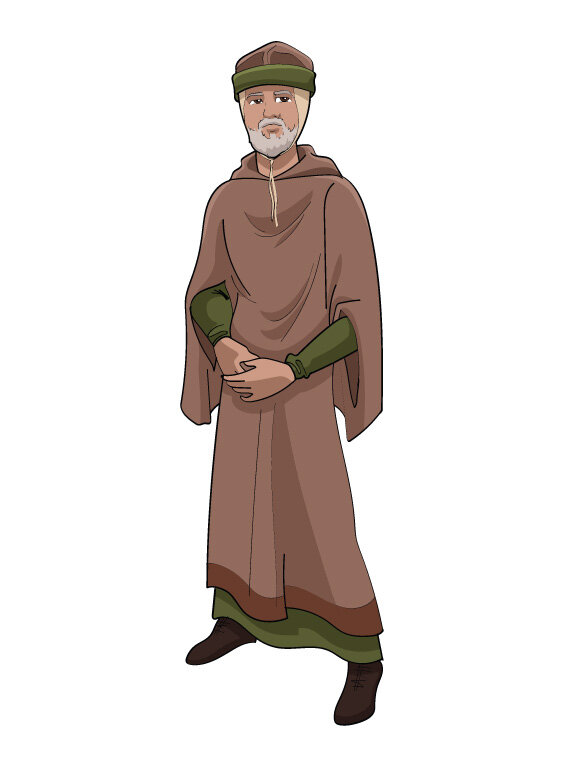
The Characters of Newcastle Castle
Who were the characters of Newcastle Castle?
All of these characters are associated with Newcastle Castle in some way, shape or form but most importantly they were kind of the ‘super-heroes’ of their time.
Sir Aymer de Atholl (Knight)
Sir Aymer de Atholl was a Northumbrian knight living in the 1300s.
The second son of an exiled Scottish Earl who had fought with King Edward of England against Robert the Bruce, Sir Aymer was an experienced soldier who saw some of the most turbulent times in British history – he lived through the time of the Hundred Years War and the wars with Scotland, the Black Death and finally the overthrow of an English King.
Sir Aymer de Atholl served King Edward III as a commissioner of array leading troops to defend the Scottish Borders against attack and in later life as Sheriff of Northumberland and Keeper of Newcastle Castle. He also owned his own rather less grand castle (more of a tower really) in Ponteland. A warrior to the end, he was captured by the Scots in 1388 after they besieged his tower, when he was at least in his 60s. He died in 1402 and was buried in St Andrews Church in Newcastle alongside his wife, Mary.
Mary Bruce
(Noble-woman)
Mary Bruce was the younger sister of Robert the Bruce, King of Scots.
In 1306, when The Bruce was living as an outlaw fighting a guerrilla war against the English, Mary was captured along with Robert’s wife and daughter by the Earl of Ross, who handed them over to Edward I. He had her imprisoned for four years in a cage exposed to public view at the Castle of Roxburgh. But in 1310 his son, Edward II, had her moved to a more comfortable imprisonment in Newcastle Castle. As a valuable hostage she was probably kept in the Castle Keep’s high-status cell.
In 1314 she was finally released after eight years of captivity when she was exchanged for English lords taken prisoner at the Battle of Bannockburn.
She went on to marry one of her brother’s supporters, and then another powerful Lord when her first husband died, becoming a major player in Scottish politics.
Matilda the Barber
(Barber-surgeon)
Matilda the Barber ran her business in the shadow of the Castle in the late 1200s.
Like a lot of ordinary people in the medieval period, we do not know all the details of her life but must piece things together from the few sources we do have. In 1296, when she appears in our records, people did not have surnames the way we do – instead their second name told you where they came from or what they did for a living. In Matilda’s case, she was a barber, which is a little bit different from the job that you might know.
A medieval barber was a medical professional – as well as cutting hair and shaving beards she also lanced boils, pulled teeth, drew blood, and even carried out basic surgery for her clients. The red and white ‘barber’s pole’ is thought to represent blood and bandages. Unlike modern surgeons, barbers were not ‘educated’ but learned on the job through a system of apprenticeship. Our records show Matilda ran a pretty successful business and would have been a respected professional in the town.
Isolde of Pandon
(Wealthy Woman)
In 1296 Isolde of Pandon was the wealthiest woman in Northumberland.
She was not royalty or of noble birth, but instead made her money in business. Although she was born in the little suburb of Pandon to the east of the town, her father was a Flemish merchant. When her first husband died she took over the family firm, and became one of the biggest wool merchants in the town. In those days, wool was the main export from Newcastle, with coal a close second. Her second husband was an Italian merchant from the town of Lucca, the centre of the Italian banking trade, putting Isolde at the forefront of European business and finance.
To Isolde, the Castle would represent the local centre of the King’s power, and she must have been all too familiar with the Sheriff, his bailiffs, and the collectors of customs duties. The King was obviously interested in getting his hands on a share of the money made by the enterprising merchants of Newcastle. By the 1330s, Newcastle was behind only London, York and Bristol in the list of wealthiest towns in England.
Adam of Alnwick
(Black Friar)
Adam of Alnwick was one of the Dominican Friars of Newcastle, known as Blackfriars for their black wool cloaks.
Friars were a lot like monks, sworn to a life of poverty, chastity, prayer and hard work. But although the individual friars were not allowed to own any property at all, that was not true for the order that they belonged to. The Blackfriars were powerful, influential and wealthy and often meddled in politics.
In the 1340s, Adam of Alnwick was accused of being one of the conspirators who murdered the former mayor of Newcastle, John of Denton. There had been violence between two rival factions in Newcastle who both wanted their candidate as mayor. John of Denton paid the price for his political ambitions, being locked in prison by his enemies and starved to death. His widow accused many of the wealthy merchants of the town, and Brother Adam of Alnwick. To him, the Castle’s Heron Pit would probably have served as a grim prison while he awaited trial. In the end he was lucky – Adam was able to obtain a royal pardon and got off scot free.
William Burntoft
(Physician)
In 1312, William Burntoft, Physician of Newcastle, was summoned to the Castle by royal command.
The King, Edward II and his close companion Piers Gaveston had fled from the anger of rebellious barons and were hiding out in Newcastle. Piers had fallen ill with what the chronicles of the time call a “secret illness” and William was called to the Castle to treat him.
As a medieval physician, William was a highly educated individual who had attended University for at least ten years and had probably studied in one of the great medical centres like Oxford, Paris, Padua or Salerno. To diagnose his patient he would have relied on a mixture of astrology, investigating the patients urine and the theory of the four humours. Not everyone in medieval England trusted physicians, with many thinking they were little more than greedy charlatans. Speaking of which, William was paid over £6 for a couple of days work treating Piers, in an age when the average wage was just 2d per day!
Odo and Eustace
(Surly Guards)
Odo and Eustace are our resident Castle Guards, and a surlier pair would be hard to find.
While the word Castle might conjure up images of noble knights riding mighty horses, the reality was often much different. In 1323 the garrison of Newcastle Castle consisted of just one knight and nine fully armed men-at-arms. The other sixty soldiers of the garrison were soldiers like Odo and Eustace, who were referred to as Hobelars. Lightly armoured and armed with a spear, they rode on little ponies called ‘hobbies’, hence their name.
Although while on guard duty or in battle they were usually on foot, the fact that they had horses made them handy for patrolling, scouting, carrying messages and other jobs where being able to ride at speed was useful. They were paid 6d per day, which although it was much less than the pay given to the knights was still twice what an ordinary foot soldier could expect. When not on active duty, gambling was a common pastime – several bone dice have been found at the Castle along with a board for playing Nine Men’s Morris.
The Gongfarmer
Our poor old gong farmer hasn’t even got a name to put to his face!
The lowliest of all the Castle’s workers, his job is to clean out the cess pits and garderobes. Needless to say with such a disgusting job, and smelling the way he does he isn’t very popular – gong farmers, like tanners and others in foul smelling professions, were forced to live on the outskirts of towns and villages.
Nonetheless, it isn’t all bad news. The gong farmer gets to keep anything he finds in the ‘gong’, so if you lose your wedding ring down the toilet, bad luck – it is finders-keepers. Gong farmers were a vital part of the Castle staff, and later on were even employed by the government of towns like Newcastle to help keep the streets clean – or at least keep the waste piled up in the midden where it belonged!
The Plague Doctor
In 1636, a devastating outbreak of the Plague struck Newcastle. By the end of the following year, nearly half the population of the town would be dead.
Doctors of the time knew nothing about what caused the plague or how it was spread, with theories ranging from clouds of foul air, poisoned wells and the wrath of God. Because most of the real physicians were rich enough to flee the town to escape the disease, that left many towns employing barely qualified Plague Doctors to investigate outbreaks and diagnose possible victims. The costume they wore was said to have been invented by a French doctor in the early 1600s, and consisted of a long robe, gloves, tall boots and the beak shaped mask that was stuffed with sweet smelling herbs to ward off the bad air.
Plague Doctors could not cure the Plague of course, but they were important in imposing quarantines, whereby infected households were isolated to prevent the spread of the disease. Despite everything they tried, in Newcastle in 1636 it was not enough, and it was said the streets were deserted until the grass began to grow through the paving.
Maurice the Engineer
(Master Mason)
Between 1168 and 1178 King Henry II of England spent about £1000 demolishing the old timber castle and having it rebuilt as a brand spanking new stone fortress.
The man charged with completing this work was known as Maurice “the Engineer”. In the middle ages the name would have conjured an image of someone who constructed “engines” of war, the great siege catapults and ballistas that were used to bring down castle walls. But Maurice had more constructive talents as well and oversaw the building of Newcastle Castle as the master mason. He would have overseen all the workers on site, serving as architect and manager for a project of staggering scale. Using his knowledge of geometry and masonry he engineered the construction of the huge stone tower at the centre of the new castle – the Castle Keep. That the Keep still stands to this day is a testament to his skill and ingenuity.
Jane Martin
Jane Martin was a woman living in the 1600s accused of witchcraft and ultimately hanged for it.
The miller's wife of Chatton, Jane would have been a highly regarded member of her community. Her and her husband would have provided the flour for those in her village to make bread. We have a very limited amount of information on Jane's life, but what we do know comes from a pamphlet titled The Wondefull Newes from the North. It is here that her sister's confession is noted. In it, her sister explains how together, they had caused harm to multiple people, as well as supposedly consulting with the devil. From these confessions, Jane and her sister are brought to Newcastle as part of the wider witch trials of 1649/1650 and tried and hanged for their crimes.
The 1600s was a tumultuous time for people living in England, and this context gives us a lot of clues as to why the Newcastle Witch Trials may have taken place.











